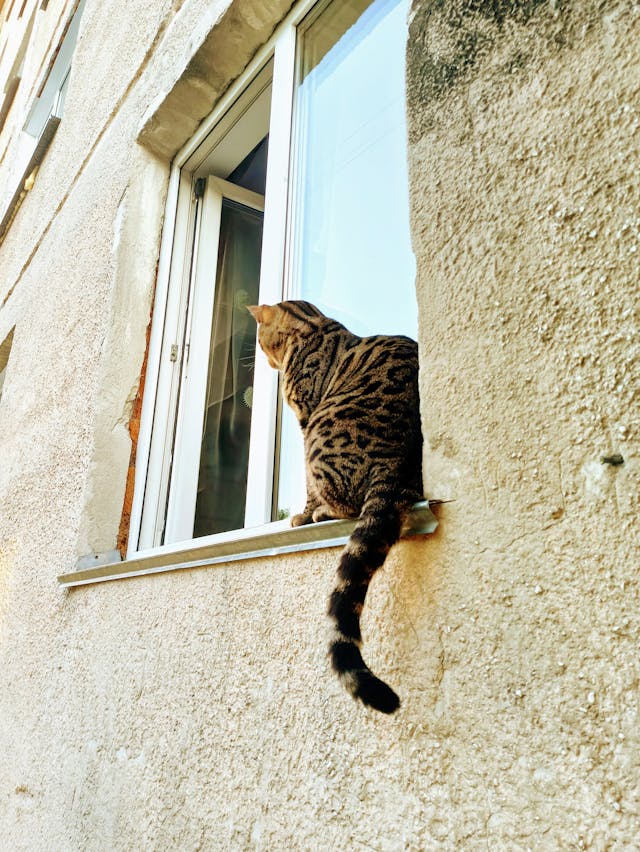Many people have the impression that cats are mysterious, fascinating animals that can confound even the most seasoned pet owners. Tail wagging is one way this inclination manifests itself. It’s a common misconception that dogs wag their tails when they’re happy, but cats don’t. A cat’s tail-wagging behaviour can indicate a range of emotions, including contentment, annoyance, or even discomfort. Understanding the meaning behind your cat’s tail movements could greatly strengthen your relationship with your pet. This website seeks to dispel any misunderstandings around cats’ tail wagging by offering advice on proper conduct and insights into the possible consequences of different tail motions.
Key Points
Tail wagging in cats is different from dogs: While dogs generally wag their tails to show happiness, cats use their tails to express a range of emotions.
Different tail movements have different meanings: A swishing tail, a twitching tail, and a puffed-up tail all convey different messages.
Understanding your cat’s body language: Paying attention to your cat’s overall body language in conjunction with tail movements can provide a clearer picture of their mood and intentions.
Responding to tail signals: Knowing how to respond to your cat’s tail movements can help in better managing their behavior and improving your relationship with them.
Cat Tail Waving’s Mechanisms
Gaining a Fundamental Knowledge of Cat Communication
Cats communicate using every part of their body, but they especially use their tails for communication. Compared to cats, dogs use their tails to communicate more quietly because most tail wagging is linked to happiness. Cats use their tails, which are an essential component of their communication repertoire, to convey a vast array of feelings and intentions.

The Various Tail Movement Types and Their Significance
1. Scrolling with caution
A cat will typically wag its tail slowly back and forth to indicate that it is either contemplative or mildly agitated. When a cat is absorbed in something, whether playing with a toy or observing a bird outside the window, this is a typical behaviour. The cat appears to be contemplating or deciding what to do next as it travels slowly and deliberately.
2. Eye Movement Quickly
A twitching tail could be a sign of excitement or impatience. It may be wise to give your cat some space if you notice that its tail twitches a lot whether it is sitting or lying down. In cats, this type of wag of the tail typically indicates overstimulation or disturbance. It may also occur while the cat is acting wildly and energetically.
3. Thumping or Pounding
A cat will obviously show that it is angry or frustrated when it thumps its tail against the floor or furniture. When a cat is unhappy with the type of companion they are having or simply wants some alone time, they often exhibit this inclination. Disregarding these cues may result in increased irritation and potentially even a bite or swat.
4. Difficulties
Generally speaking, a twitching tail indicates extreme happiness or excitement in a cat. This is how a cat will typically greet its owner or another person it knows well. Due to the presence of scent glands near the base of their tails, cats may also be marking their territory with a quivering tail.
5. The Tail Spreads
A cat will obviously show fear or hostility when its tail puffs out like a bottle brush. The cat adopts this defensive stance to make itself appear bigger and more menacing to any onlookers or possible predators. Hissing and an arched back are common side symptoms.
6. Covered Tail
A cat that twirls its tail around itself or another cat is usually indicating comfort or affection. When a cat is content and at ease, they frequently display this behaviour, whether they are snoozing or simply lounging close to a person or another cat they find admirable.

Integrating Other Body Language with Tail Movements
Pay attention to your cat’s tail movements as well; these are just one more way that they are communicating with you. A cat that, for instance, wags its tail high and slowly to show that it is interested in something is most likely interested in something. On the other hand, a cat who has dilated pupils, a quick twitching tail, and flattened ears is either exceedingly concerned or scared.
How to React to Tail Movements in Your Cat
1. Be mindful of their personal space
Give your cat some space if they are twitching or beating their tail. When your cat exhibits these behaviours, it may not be a good idea to interact with them since they are upset or distressed.
2. Attractive for Play
A twitching tail usually indicates that your cat is pleased or excited. During this time, playing with your cat, giving them toys, or engaging in enjoyable interactive activities are all great options. In addition to giving your cat the much-needed mental and physical stimulation, this can strengthen your bond with them.
3. Provide Comfort
Try to soothe your cat if its tail is puffed out by speaking softly and avoiding abrupt movements. If you give your cat a calm and secure environment, it will feel less nervous and more certain.
4. Express Your Love
Your cat is expressing its love for you when it tucks its tail around you. To strengthen your relationship and express your gratitude for your cat’s adoration, give it soft pats and encouraging words in return.


Last Thoughts
Comprehending your cat’s tail movements is essential to comprehending their communication. If you pay attention to these subtle cues that tell you what your cat wants and feels, you and your cat can enjoy a closer, calmer connection. The way your cat waves their tail can reveal a lot about their emotional state, including whether they are playful, annoyed, or friendly. With this understanding, you can respond to them in a way that reassures, comforts, and understands them. Understanding your cat’s nonverbal cues will strengthen your bond with them and raise their general level of contentment.



